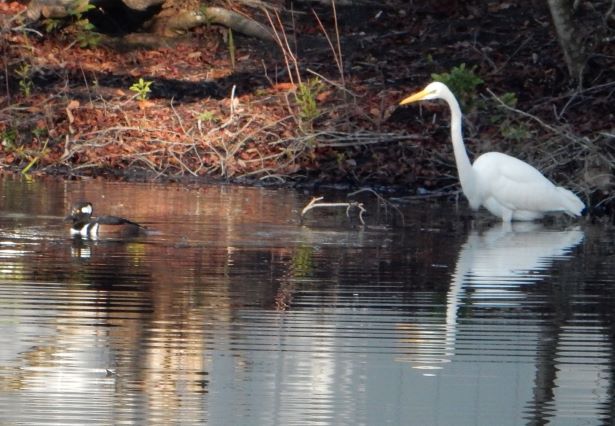By Pat Foster-Turley, Ph.D.
February 17, 2022

Well, I’m back from a vacation in Costa Rica centered on watching wildlife and arrived home to see the wildlife show in full swing in our own backyard in Fernandina. All the main bird characters are here! I can see most of them right from my bed in the morning. And there is always something going on with them these days.
Our backyard retention pond hosts different birds sporadically over the seasons, but now, late winter, is the best time of all to watch their interactions. It takes a lot of shuffling around, some conflicts, and some cooperative endeavors for them all to enjoy the rewards of the pond.
Year-round the pond hosts a great blue heron, which changes its feathering as it gets closer to breeding season. Right now its breeding plumage is already something to admire and it will have a nest elsewhere to really show off its finery but hopefully will still fish sometimes in the pond. Often a great white egret joins the blue heron on the far bank seeking its own prey. Sometimes a snowy egret shows up too. And now a tri-colored heron has joined in as well. Some mornings I see all of them lined up along the far bank, social distanced from one another.

And then there are the wood storks. For a week now, maybe months, a lone wood stork has been hanging around the far side of the pond probing for prey, and recently another wood stork joined it. But alas, this partnership was not to last for long. A flock of geese has moved in too, and apparently they don’t like wood storks. One morning there was a kerfuffle in the pond, with squawking and wings flashing and we watched as the geese drove away the wood storks. They have not returned, at least so far.
But the geese do not seem to be bothered by the egrets and herons, and they let them fish right near the place where they are resting, feathers unruffled. And other water birds have joined the festivities at the pond and are pitching in to help the egrets and herons. A group of hooded mergansers now is floating around the pond too. They are more suspicious of me with my camera on shore, but if I stay inside to watch I can witness cooperative fishing between them all. The mergansers chase fish in the water towards the shoreline and the egrets and herons can catch them more easily. But the fish they miss swim back from the shore where the mergansers can nab them too. Sometimes even the resident anhinga dives under to join the pack effort of catching fish. A kingfisher often perches on nearby branches looking for its own fish to be disturbed in the melee. The geese, plant eaters mostly, just passively watch.

Soon the dynamics at the pond will change. The herons and egrets will join their kin in breeding rookeries, maybe far from this pond. The mergansers never stay around here long either, as they are here only for the winter and fly off somewhere else to breed. The geese are getting ready for their spring breeding cycle, when only two of the six geese in the pond will claim the old nest site at the drainage outflow. The group of geese will disturb the pond residents with their noisy honking and territorial disputes until one pair takes ownership of the previous nest site. Soon enough there will be goslings following the geese around in the water, then all of them will walk off somewhere else too.
And then we will be left with the resident kingfisher and anhinga that are always nearby. And more than likely the herons and egrets and wood storks will return and life will go on at the pond, as it has for the many years we’ve been watching.
There may not be much biodiversity left in this retention pond, as it gets more and more contaminated by lawn pesticides and herbicides that wash into it and kill the pond plants and insects and frogs that need aquatic plants to complete their food chains. But at least we can still enjoy the fish-eating birds.
Pat Foster-Turley, Ph.D. is a zoologist on Amelia Island. She welcomes your nature questions and observations. [email protected]

Enjoy it while it lasts Pat. The developers have their sights set on draining all the remaining wetlands & killing off all the rest of the trees on the Island for constructing new homes, subdivisions &, businesses. Doesn’t matter if it’s a wildlife habitat. Property sales & profits are way more important than us & the birds.